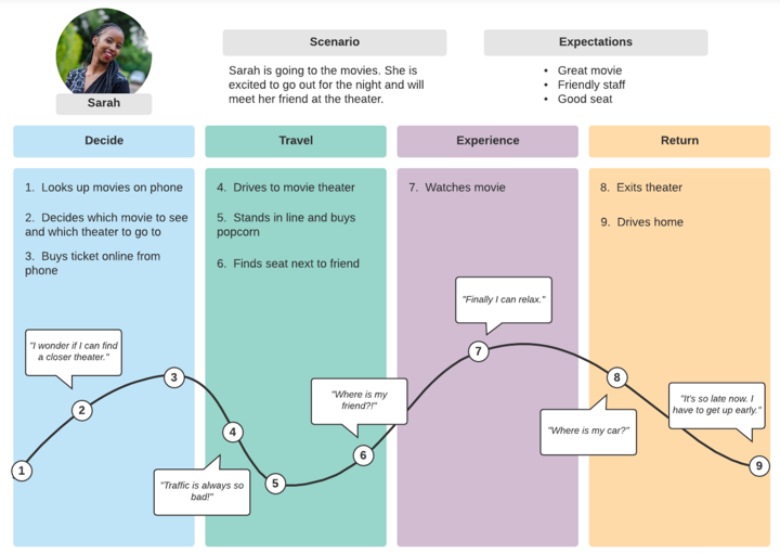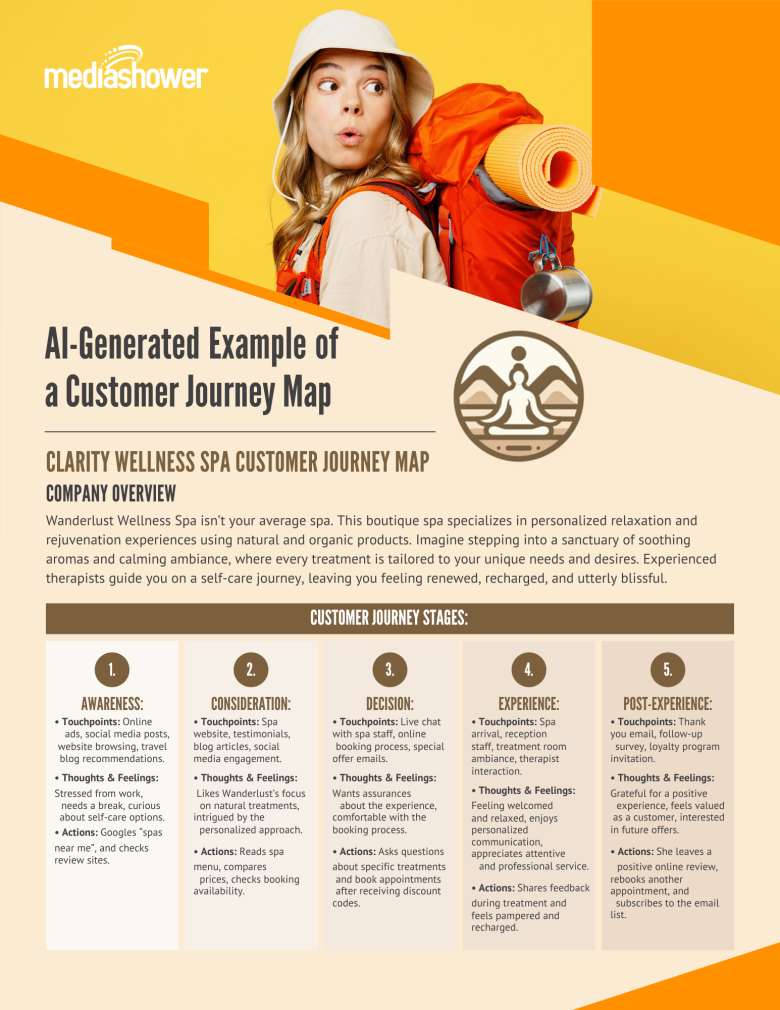Customer Journey Map Generator (with Templates and Prompts)
If you’re trying to map your customer journey from first click to final sale, try out our AI-powered Customer Journey Map Generator. It’s one of dozens of AI marketing tools you’ll get in the Media Shower platform: click here for a free trial.
How to Use our Customer Journey Map Generator
Just answer a few questions, and our AI-powered Customer Journey Map Generator will list out all the customer touchpoints, from initial contact with your brand to the final purchase (and beyond!) Remember, the more details you give it, the better your customer journey map will get.
More AI Prompts for Customer Journey Maps
Once you’ve drafted your customer journey map above, here are more refined prompts you can use to polish and perfect it:
- To improve tone and style: Rewrite this section to convey a more formal/playful/authoritative tone.
- To enhance emotional appeal: Suggest ways to evoke stronger emotions at this touchpoint.
- To optimize customer touchpoints: Identify potential friction points and propose solutions to improve customer interactions.
- To refine messaging clarity: Reword this sentence to make it more concise and easier to understand.
- To personalize communication: Provide suggestions on how to tailor messaging to individual customer segments.
- To identify cross-selling opportunities: Highlight potential product or service recommendations that align with the customer’s journey.
- To capture customer feedback: Devise strategies to collect customer feedback at various touchpoints for continuous improvement.
- To streamline the path to conversion: Recommend ways to simplify the customer journey and reduce barriers to purchase.
- To integrate omnichannel experiences: Propose methods to create a seamless experience across multiple channels and devices.
- To optimize customer support: Offer ideas for improving the customer support process and ensuring timely resolution of issues.
Examples of Customer Journey Maps
Customer journey maps are crucial for businesses because they visually represent your customer’s experience, from initial awareness to purchase and beyond. Here are industry examples of effective customer journey maps:
Slack: Adoption and Value Journey
 Image Source: Medium
Image Source: Medium
Analysis:
- The map identifies key touchpoints in the user journey: Awareness, Usage, Increased Usage, and End Usage. These touchpoints are when users interact with Slack, such as downloading the app, joining a workspace, and sending messages.
- The map uses a customer stand-in, “Cecelia,” to humanize the product and user interactions.
- The map identifies both positive and negative aspects of the user experience. For example, the map shows that Cecelia likes using Slack more than email but is also frustrated by the notifications she receives.
- The map uses emojis and a color-coded system to show the user’s emotional state at each journey stage while streamlining interpretation.
Lucid Chart: Basic Customer Journey Map
 Image Source: LucidChart
Image Source: LucidChart
Analysis:
- This chart incorporates a mini-buyer persona, helping viewers connect with the customer on an emotional level and making the journey more relatable and engaging.
- It divides each action into steps and offers granular detail, providing a deeper understanding of the customer’s thought process and potential pain points at each stage.
- Using numerical steps to represent actions adds a layer of objectivity and clarity, making it easier to analyze unique customer data at each stage and identify areas for improvement.
- Using color and visual elements enhances understanding and makes the map more memorable.
AI-Generated Example of a Customer Journey Map

10 Best Practices for Customer Journey Mapping
- Clearly define your customer personas: Develop detailed profiles of your target audience, including demographics, motivations, goals, and pain points. Develop a detailed profile: her age, self-care needs, and budget. What excites her about your product? What roadblocks frustrate her? This helps tailor the journey map to their specific needs.
See Mailchimp’s Persona Guide, which offers tips for creating effective customer personas. - Start with a specific goal: Set a clear objective for your journey map, such as increasing customer retention or reducing cart abandonment. This guides the focus and prioritization of touchpoints. Don’t get lost in the details. Set a clear objective, like increasing customer retention.
- Map multiple touchpoints: Mapping multiple touchpoints in your customer journey map is vital because it unveils how customers interact with your brand. Identifying and mapping all customer interactions with your brand is crucial, from awareness to post-purchase stages. This includes online, offline, and direct interactions.
See this Qualtrics guide here for examples of customer touchpoints and why they are important. - Incorporate emotions and motivations: Understand the feelings and drivers behind customer actions, like excitement during discovery or frustration with complex features. This helps create more emotional engagement. It goes beyond actions and reveals the “why” behind them.
- Collect and analyze data: Gather data from surveys, analytics, customer feedback, and other sources to inform your map and validate assumptions. This ensures data-driven decision-making. Numbers can unveil hidden frustrations. Use data to pinpoint areas for improvement.
- Monitor and measure success: Customer journeys are dynamic. Ongoing monitoring helps you adapt to changing trends, competitor actions, and evolving customer expectations. Keep your map relevant and effective over time. You can measure the success of your customer journey by relying on customer journey analytics.
The Media Shower platform gives you access to dozens of AI-powered marketing assistants like this one. Click here for a free trial.


